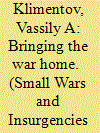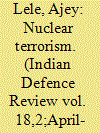|
|
|
Sort Order |
|
|
|
Items / Page
|
|
|
|
|
|
|
| Srl | Item |
| 1 |
ID:
178561


|
|
|
|
|
| Summary/Abstract |
Terrorism connected to the North Caucasus has been pervasive in Russia between 1992 and 2018. Based on an original dataset, this article presents statistics on rates of terrorist attacks outside of the North Caucasus, their geography and targets, and the tactics used. It argues that terrorism by North Caucasian insurgents has long retained a strategic logic despite their conversion to radical Islamism. Accordingly, the end of North Caucasian terrorism was determined by the erosion of its strategic character as an increasingly vague ideological project replaced concrete political goals among the insurgents.
|
|
|
|
|
|
|
|
|
|
|
|
|
|
|
|
| 2 |
ID:
169916


|
|
|
|
|
| Summary/Abstract |
Historians of terrorism note that modern terrorists rely almost exclusively on two weapon types: the gun and the bomb. However, the comparative use of these weapons differs from one terrorist group to the next. We exploit this variation to examine how the tactical decisions of terrorists respond to both strategic aspirations and resource constraints. We argue that a group’s goals (a strategic consideration) and size (a resource constraint) provide a parsimonious explanation for weapon selection. Because firearms inherently expose the shooter to higher risk, are more precise, and must be used if a group aspires to maintain social order, they are unlikely to be used by groups with limited recruits in a campaign of violence. We test this theory using data on over 350 terrorist organizations. Our analysis shows that strategic considerations and resource constraints both impact tactical choices, although groups with the most expansive goals, those which transcend national borders, as well as militias, are two interesting exceptions to our theory. Our research has implications for the use of disaggregated tactical data and in furthering our understanding of the rationality of terrorism.
|
|
|
|
|
|
|
|
|
|
|
|
|
|
|
|
| 3 |
ID:
183009


|
|
|
|
|
| Summary/Abstract |
Terrorist organizations destabilize governments through violent and coercive acts that include the use of water resources as a target. Scholars in security studies recognize water as a strategic resource but have yet to systematically quantify and describe how water is used in the case of terrorism. This paper explores this gap at the nexus of the larger fields of terrorism and environmental security by offering methods to codify types of water-related terrorism events. Using the University of Maryland’s Global Terrorism Database, which includes information on terrorist events around the world, and employing aggregate data analysis, we highlight trends over time and space. We found that water-related terrorism is a method of terrorism widespread across most of the world and that water infrastructure is the main target of choice by most terrorist organizations. We identified 675 incidents of water-related terrorism that occurred in seventy-one countries. We identified terrorist organizations with the highest numbers of incidents and transboundary water basins most at risk for water-related terrorism incidents. This collective analysis identifies and codifies the number and type of water-related terrorism incidents that occurred from 1970 to 2016; describes spatial and temporal trends of those incidents; and provides information for decision-makers regarding water-related terrorism targets and associated risk.
|
|
|
|
|
|
|
|
|
|
|
|
|
|
|
|
| 4 |
ID:
055877


|
|
|
| 5 |
ID:
153909


|
|
|
|
|
| Summary/Abstract |
Why do armed groups ever direct violent attacks against humanitarian organizations? While scholars have analyzed wartime violence against civilians, little research exists on violence against other noncombatants, like humanitarian organizations. Violence against aid workers, however, is common in wartime, with devastating consequences for civilians, who suffer when aid organizations respond by reducing services. This article argues that much of the violence against humanitarian organizations is strategic. By serving as substitute providers of public goods, aid organizations can bolster the government. Insurgents thus target aid workers in an effort to force them out of particular regions, undermining government support. To test this argument, we analyze variation in violence across space and time using an original panel dataset on attacks against aid workers in Afghanistan, 2008–2012. Despite aid organizations’ attempts to remain neutral, we find evidence that insurgents strategically target aid workers in areas where their services likely strengthen government support.
|
|
|
|
|
|
|
|
|
|
|
|
|
|
|
|
| 6 |
ID:
175710


|
|
|
|
|
| Summary/Abstract |
Our article challenges a common discourse that terrorist groups are relatively disinterested in territory by exploring emerging theories about territory and territoriality. We use these theories to introduce a new conceptual model of the importance of territory for terrorism that contrasts a group’s Sovereignty Claims over Territory (SCOT), which corresponds with the ultimate territorial aims of the group, with its Effective Control of Territory (ECOT), which relates to the ability of an organization to exert influence over a particular territory. Contrasting these dimensions of territory allows us to develop several archetypes of territorially-motivated terrorism. Our model predicts that, in contrast to common deterritorial discourses, truly non-territorial terrorism is likely to be quite rare as most groups engaged in violence have territorial ambitions in one way or another. We then use our model to interrogate the salience of territory to three representative cases: the Islamic State, ETA, and FARC-EP. Our analysis shows that territory remains a central motivating factor for these groups as their overall territorial aims tend to remain constant whereas their ability to control territory is more susceptible to change. We conclude by discussing the implications of our model and analysis for future research.
|
|
|
|
|
|
|
|
|
|
|
|
|
|
|
|
|
|
|
|
|